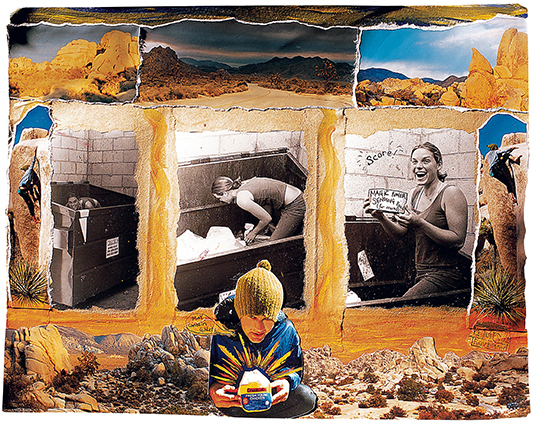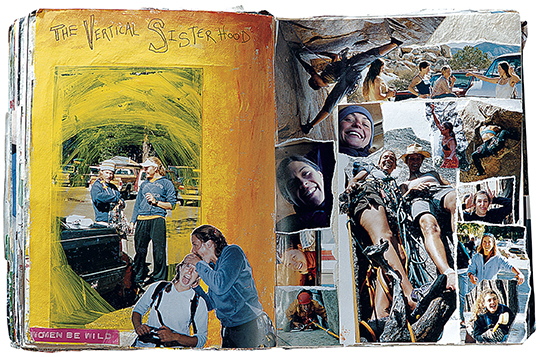
[Collage] Emilie Lee
TWELVE YEARS AGO, I was knee-deep in a dumpster digging for groceries. Inspired by legends like Yvon Chouinard, who famously lived on cat food for a summer, my friends and I considered bruised apples and stale bread to be a blessing that allowed us to extend our climbing trips from weeks into months. We had serious ambitions in the mountains, but I believe the real thing we were after was a kind of purity. In those days, there were no smartphones or digital cameras at the crags. Each time we slipped past the park-service gate in Joshua Tree, we thought we’d left behind the constructed realities of civilization–crossing over into a world of improbably shaped granite boulders, wacky trees and bold desert flowers. Just by its appearance, this place encouraged our imaginations to stretch and run free. By day we wandered the maze of towering fortresses, mostly climbing and exploring, but also playing music and creating artwork, photos and poetry. At night, we went on long walkabouts under the stars, tapping into our animal intuition in silent dances across the rocks.

[Collage] Emilie Lee
Now, when I flip through the pages of the journal I kept that season, I see the true value of time spent in the wild. As Teddy Roosevelt said of his formative adventures in North Dakota, “It was here that the romance of my life began.” At a crucial period of our youth when we were forming our worldviews, we had the chance to test the limits of our creativity and strength. Chris Harth, who was shooting a film in the desert when we met, went on to work as an art producer in New York before starting a custom woodworking business. Renan Ozturk’s artwork has evolved from sketches made on cardboard scraps into massive canvases and films depicting the surreal landscapes of remote ranges. After climbing big walls in Pakistan, Nick Martino has learned Arabic, studied Middle Eastern politics and worked with Iraqi refugees. Others have become professional climbers, writers, parents, artists and entrepreneurs, and when we talk now, it’s clear how meaningful that season was for us–a chrysalis for the rest of our existence. Back then, my paintings and journals expressed the simple, youthful joy I found in the climbing life. I’ve since moved to New York City. Amid a fast-paced culture of ambition and energy, my perspective has changed. I continue to spend extended periods of time in mountains and deserts, but I no longer wish to hide there. Instead, I hope that we’ll have the restraint to leave such wild places intact, so that we can all go there and be reminded, still, of how small we are in the face of nature’s infinite complexity. —Emilie Lee
[In 2004, Alpinist 6 showcased the art of Emilie Lee in a series called “Dumpster Diaries,” depicting one spring in the lives of her fellow climbers and artists.–Ed.]